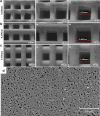Three-Dimensional Printing Bioceramic Scaffolds Using Direct-Ink-Writing for Craniomaxillofacial Bone Regeneration
- PMID: 37463403
- PMCID: PMC10495199
- DOI: 10.1089/ten.tec.2023.0082
Three-Dimensional Printing Bioceramic Scaffolds Using Direct-Ink-Writing for Craniomaxillofacial Bone Regeneration
Abstract
Defects characterized as large osseous voids in bone, in certain circumstances, are difficult to treat, requiring extensive treatments which lead to an increased financial burden, pain, and prolonged hospital stays. Grafts exist to aid in bone tissue regeneration (BTR), among which ceramic-based grafts have become increasingly popular due to their biocompatibility and resorbability. BTR using bioceramic materials such as β-tricalcium phosphate has seen tremendous progress and has been extensively used in the fabrication of biomimetic scaffolds through the three-dimensional printing (3DP) workflow. 3DP has hence revolutionized BTR by offering unparalleled potential for the creation of complex, patient, and anatomic location-specific structures. More importantly, it has enabled the production of biomimetic scaffolds with porous structures that mimic the natural extracellular matrix while allowing for cell growth-a critical factor in determining the overall success of the BTR modality. While the concept of 3DP bioceramic bone tissue scaffolds for human applications is nascent, numerous studies have highlighted its potential in restoring both form and function of critically sized defects in a wide variety of translational models. In this review, we summarize these recent advancements and present a review of the engineering principles and methodologies that are vital for using 3DP technology for craniomaxillofacial reconstructive applications. Moreover, we highlight future advances in the field of dynamic 3D printed constructs via shape-memory effect, and comment on pharmacological manipulation and bioactive molecules required to treat a wider range of boney defects.
Keywords: 3D printing; bone regeneration; in vivo; preclinical; regenerative medicine; scaffold.
Conflict of interest statement
No competing financial interests exist.
Figures









References
-
- Lanza RP. Principles of Tissue Engineering, 5th ed: Academic Press: London; 2020.
-
- Seper L, Piffkó J, Joos U, et al. . Treatment of fractures of the atrophic mandible in the elderly. J Am Geriatr Soc 2004;52(9):1583–1584. - PubMed
-
- Kenley RA, Yim K, Abrams J, et al. . Biotechnology and bone graft substitutes. Pharm Res 1993;10(10):1393–1401. - PubMed
Publication types
MeSH terms
Grants and funding
LinkOut - more resources
Full Text Sources

